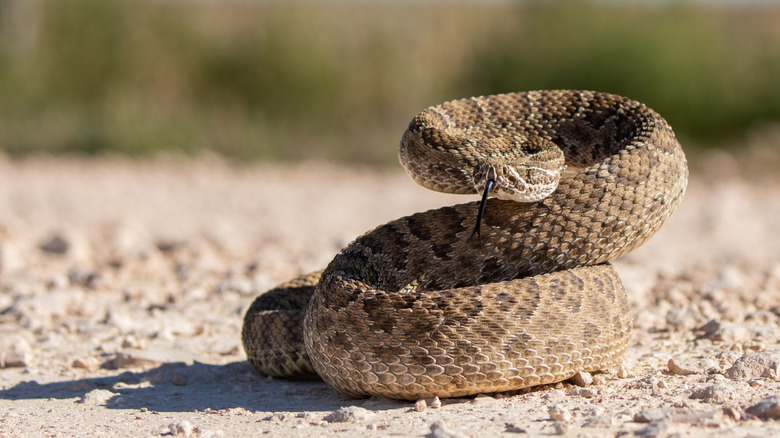The US State With The Most Snake Species Isn't For The Faint Of Heart
They say everything's bigger in Texas — and apparently, that even includes populations of snakes. The Lone Star State is teeming with the scaly reptiles, according to a 2025 index from the World Population Review. The report found that Texas has a whopping 68 species of snake, which is just a few digits shy of the Texas Parks and Wildlife's official count of 76.
As you can imagine, keeping track of all the different types of elusive serpents that slither around the great plains isn't easy. Whether the exact number is 68, 76, or somewhere in between, Texas still has far more snake species than any other state in the country. And if you take into account the region's various subspecies, that figure balloons to well over 100. Yikes. Texas ain't for the faint of heart, that's for sure.
As for the World Population Review's ranking, Mississippi, with its many snake-filled lakes and rivers, came in at a close second with 55 different species. Arizona, a state that has more rattlesnakes than any other, and Nevada went neck in neck for third place, each boasting 52. If you suffer from a bad case of ophidiophobia — aka, a fear of snakes — you may be reconsidering any planned upcoming trips down South right about now, but fret not. Generally speaking, snakes are actually pretty timid and shy.
Texas' snakes aren't as bad as you think
The cunning serpent that tempted Eve in the Garden of Eden ages ago may have given snakes a bad rap, but they're more harmless than you think. Of Texas' 70-ish species, only 15 are venomous. These include copperheads, known for their distinct tan-colored and hourglass-shaped crossbands; cottonmouths, whose thick bodies can vary in color from brown to almost black; and rattlesnakes, which you'll likely hear long before you see them coming.
Coral snakes are another potentially dangerous variety, having inspired the old rhyme: "Red against yellow, you're a dead fellow. Red against black, you're okay, Jack" — which doesn't necessarily always ring true, by the way. Venomous or not, you should try to steer clear of snakes. "When you encounter a snake, it's best to just leave it alone," Dr. Maureen Frank, an assistant professor and wildlife specialist with Texas A&M AgriLife Extension Service, explains in one of the university's blog posts. "Most bites occur when a person is trying to handle the snake or trying to kill it. It's best to give them plenty of room and let them go on their way."
Snakes will typically only strike if they view a person as a threat, so let the slithering creatures go on their merry way. They have important jobs to do, after all. The coiling reptiles play an incredibly important role in their ecosystems. They promote biodiversity and help keep populations of other critters in check, such as insects and rodents. Talk about friend not foe.
The reason Texas is teeming with snakes
Texas is big — the largest state in all of the contiguous United States. So it makes sense that with all that land comes all those snakes. The Lone Star State's prolific populations of snakes also stem from the fact that there's a varying degree of habitats to choose from, which allows the sinuous reptiles to thrive.
Central Texas, in particular, teems with a bit of everything: hilly plateaus, lush woodlands, sprawling prairies, and too many rivers and creeks to name. For this reason, the region boasts a large concentration of snake species. Some of the non-venomous varieties that are commonly found in the area include Western rat snakes, bullsnakes, prairie kingsnakes, coachwhips, and racers.
Snakes are also cold-blooded — meaning, they can't generate their own heat. They aren't a fan of extremely cold environments, which is why you won't see snakes in Iceland. Since they prefer mild to warm climates, Texas, with its long warm season, is a more favorable place to hunker down. Whilst out on a hike, don't be surprised if you see them rolled up on a rock by the trail, trying to bask in the sun's rays during the cooler times of the day. On the other hand, when it's sweltering hot, they'll likely be seeking a shady spot to cool down. Turns out, they're more like humans than you think.


